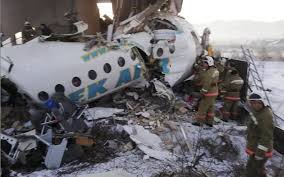‘Wake turbulence’ cited as possible cause of Bek Air crash

The Bek Air crash in Kazakhstan last week may have been caused by a ‘wingtip vortex.’
The Fokker-100 plane crashed at Almaty Airport after losing height on take-off.
It crashed through a concrete fence and slammed into a two-storey building.
The airline says the wingtip vortex or wake turbulence, was a possible cause which came from a larger Airbus jet which took off just two minutes earlier.
Wingtip vortices are rotating air patterns left behind a wing and can linger for about three minutes.
This can impact the ability of a smaller plane to take off safely.
In suggesting the cause, Bek Air chief executive Nurlan Zhumasultanov indirectly laid the blame on the airport’s air traffic control for clearing its plane to take-off too early.
Fokker 100 aircraft have been temporarily grounded and Bek Air has halted operations pending a preliminary report which should be released on January 10.
Kazakhstan’s state-run ATC authority Kazaeronavigatsias said there was a 1-minute, 52-second gap between the take-offs, which is within standard regulations as both jet types are classed as medium sized.
It comes two days after Kazakhstan observed a national day of mourning for 12 people who died on the flight.
TravelMole Editorial Team
Editor for TravelMole North America and Asia pacific regions. Ray is a highly experienced (15+ years) skilled journalist and editor predominantly in travel, hospitality and lifestyle working with a huge number of major market-leading brands. He has also cover in-depth news, interviews and features in general business, finance, tech and geopolitical issues for a select few major news outlets and publishers.
 United Kingdom
United Kingdom United States
United States Asia Pacific
Asia Pacific












































Dozens fall ill in P&O Cruises ship outbreak
Turkish Airlines flight in emergency landing after pilot dies
Unexpected wave rocks cruise ship
Woman dies after going overboard in English Channel
Foreign Office issues travel advisory for winter sun destinations